News
Article
Patients, Pharmacists, and Other Caregivers Beginning to Realize Potential of AI
Author(s):
A well-executed, human-like digital relationship can transform patient engagement to patient activation.
A recent Gartner survey found that only 8% of participants had ever used a chatbot before, and that only one-quarter of those participants would use that chatbot again. This has provided the final motivation I need to unleash a rant that has been building for more than a decade. I am compelled to start the rant by putting to bed the popular notion that consumers simply prefer to talk to a human: NO! NO! NO! What consumers want is resolution.
Image credit: Supatman | stock.adobe.com
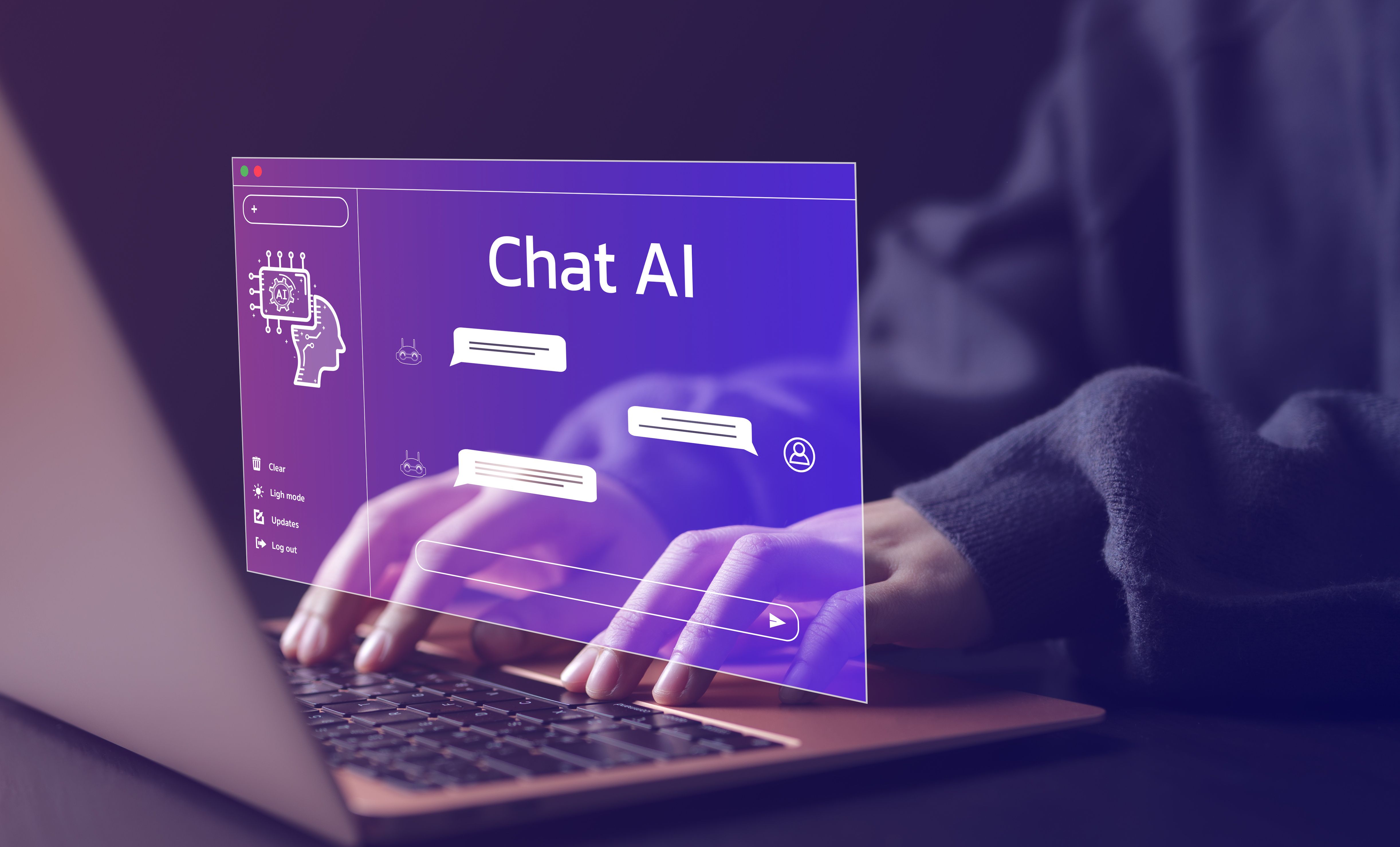
It’s quite convenient to blame consumers for all the poorly executed chatbots that litter the landscape. But the truth is, we have been diligently reinforcing the tightly held consumer belief that the only way to get resolution is to talk to a human for decades by continuing to offer mostly terrible non-human B2C digital experiences.
Why are they terrible? Because by and large, we build them to increase call center efficiencies, when in reality, the technology has been advanced enough to focus on delivering a better consumer experience for a long time. In fairness, there are a select few chatbots that have been infused with enough natural language understanding and CRM integration to demonstrate that they can improve CSAT scores, increase revenues, and improve contact center efficiencies. Unfortunately, there are far too few.
The problem is that all the bad chatbots and rigid decision trees have poisoned the well and thirsty consumers are loath to take a chance on drinking from the cups of the few good ones. So here we are today, at a place where many companies have proudly checked the box on getting a chatbot launched, while remaining hopelessly glued to the bottom of Gartner’s dreaded Trough of Disillusionment. Yes, I said it, and with that off my chest, I will focus the remainder of my screed on the enormous opportunity we have, post ChatGPT, to transform the way we engage and activate consumers with a special focus on health.
In a nutshell, the overarching problem with the current generation of chatbots is that they are conversationally challenged, limited in their ability to operate contextually and thus deliver an experience that is far too rigid and entirely transactional. To make matters worse, because they don’t remember you and are typically unable to access and/or react to CRM context on you in real-time, every time you engage them, it’s like ‘50 First Dates;’ you are starting from the beginning every time.
Dave Bulger, founder and COO of Tuzag compares and contrasts chatbots and the opportunity conversational AI brings to the table.
“Chatbots are largely self-service versions of the call tree flowcharts that a customer service representative might use to help a patient look up information,” he said. “While somewhat useful for answering FAQs, they are completely inadequate for effectively engaging consumers and delivering the quick personalized resolution they need to achieve activation.”
So by and large, consumers view chatbots as a tall speed bump on the way to getting to a human, in the hope they will get some level of resolution if they can break out of voice system hell. How many times have we all hit ’0’ or yelled "agent” repeatedly to get to a human.
And then of course, to our collective chagrin, the human starts the triage process all over again. Tragically, many times, even the humans don't have the ability or authority to deviate very far from the tree and end up sending consumers and businesses even deeper into the trough of consumer disillusionment.
“It's not enough to merely put the right information or suggestion in front of someone, you need to tailor resolution to the recipient's unique needs, wants, environment and attitudinal/behavioral dispositions. It's less about delivering information and more about catering responses and next best actions to the consumers unique intent or needs,” Bulger said. “A conversational AI concierge or coach, on the other hand, acts more like a knowledgeable advocate, that is able to use your unique context and natural language processing to understand what the consumer is trying to do (the intent) and then provide the single best resolution or action.”
With consumer health, this affords an opportunity to move well beyond patient engagement to the holy grail of activation, and includes building a human-like relationship with the consumer that greatly accelerates our progress toward the quadruple aim; particularly as it relates to enhancing the patient experience. Imagine having a digital assistant that is capable of assisting consumers with setting and achieving intrinsic personal and clinical goals that are related to their unique motivators for well-being.
We are not rational human beings, so simply delivering one-size-fits-all information in random transactions, without any semblance of a trusted digital connection/relationship has not and will not ever work. We must move from informational engagement to activation. To make this leap requires a knowledge base with significantly more fidelity and capability than simple chatbots can manage. Table 1 offers additional insights into the differences between chatbots and conversational AI.
Table 1
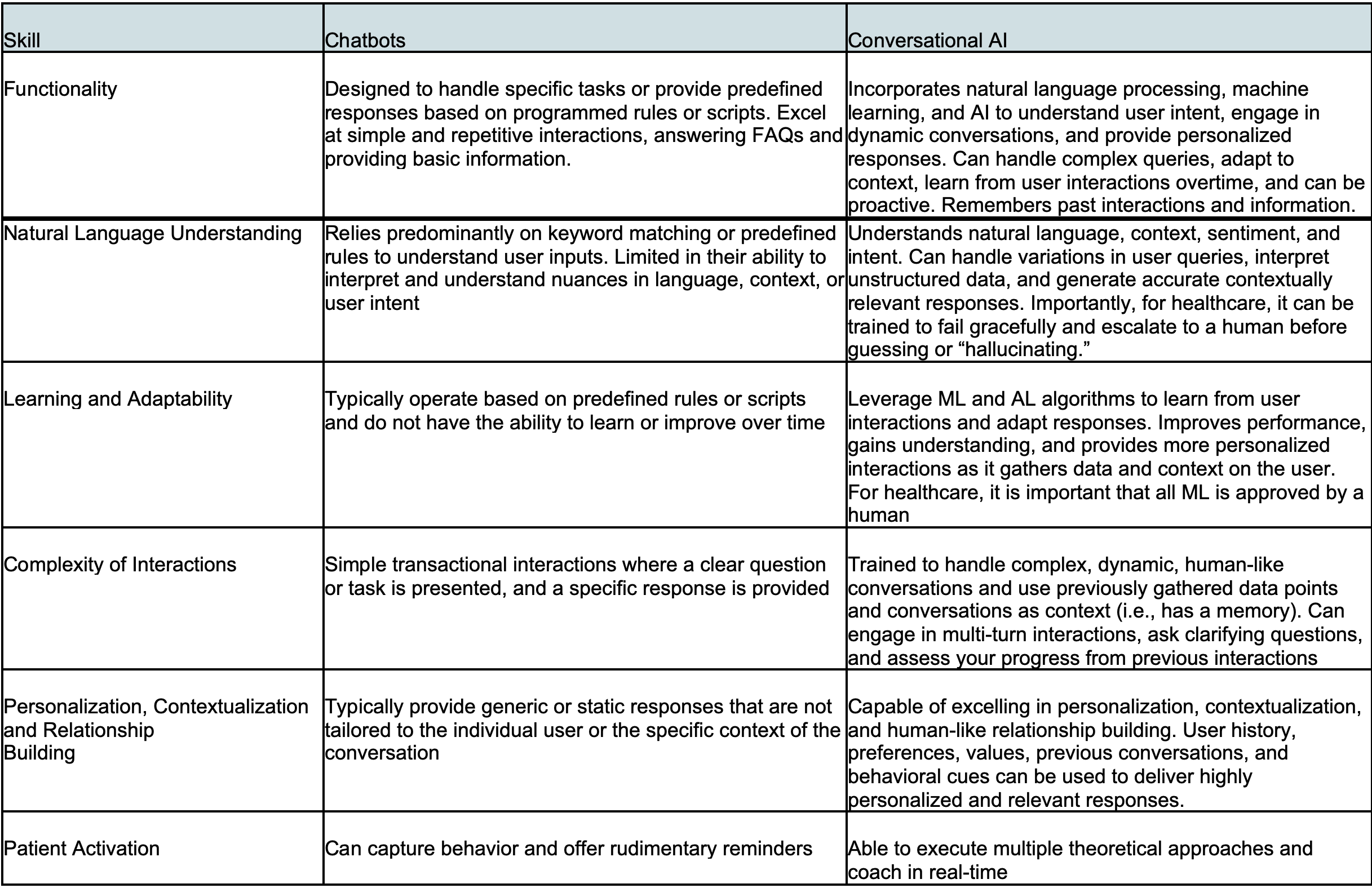
Setting aside the critically important need to accommodate ethical, moral, bias, and privacy concerns, the contours of how a well-executed, human-like digital relationship can transform patient engagement to patient activation becomes readily apparent and achievable, which leads to a second rant.
Please, no more arguments about replacing health care providers (HCPs) or other allied health professionals with AI. This is not an “either/or” proposition. Never was, and never should be. This is an “and” proposition. Transformation can only be achieved if human and health resources are effectively augmented with AI and positioned prominently in the consumer's personalized health ecosystem.
The challenge is that right now, we are barely reaching the sickest 2%-5% of our patients with HCPs. There are 525,600 minutes in a year and the average American will spend less than an hour with an HCP. Health (and chronic disease) happens every minute of every day and is tied inextricably to poor behaviors. A recent Time article screamed the truth: Behavior Is a Miracle Drug For Our Health.
Obviously, we cannot accommodate consumers’ real-time behavior change needs with HCPs. This is a loud proclamation and mandate for us to augment them with the ability to engage consumers 24/7 with behavior-based digital health concierges and coaches who are fully integrated into a consumer’s comprehensive health ecosystem. In fact, there is growing evidence that consumers can learn to trust, and indeed, might prefer engaging with a digital health assistant for some interactions.
Let's explore a real world simplistic but brilliant example of how conversational AI, done well, can overcome chatbot resistance, augment human capabilities, and actually improve CSAT, activation rates, and clinical outcomes:
A member contacts the payer with what seems like a simple question about their maternity benefits. Today, whether it is a CSR or a decent chatbot, they find out what plan and/or employer you are connected to, bring up the screens that present your medical and pharmacy benefits (no, they are not in the same database), and then give you your out-of-pocket costs for a provider visit.
If they are really good, they may also bring up another screen to check your deductible so they can also let you know whether a co-pay applies at this point or whether the visit is going to be totally out of pocket. This capability is very much within reach of some of the better chatbots and CSRs. So, a good engagement has become great, right? No! We’ve just scratched the surface of great.
Significant CSAT improvement and behavior changing opportunities are being left on the table in this scenario. What is the member really asking? People don’t call and ask about their benefits like they might call to find out last night’s baseball score.
Likely they have some underlying issue they are trying to resolve and they think knowing their maternity benefit is the resolution. When a consumer asks, “What is my maternity benefit?” we should immediately try to assess why they want this information.
Are they trying to get pregnant and having problems? Are they terrified they are pregnant and need help? Maybe they think they are pregnant, thrilled, and can’t wait to get started on their prenatal care journey to parenthood.
Having this kind of additional context puts a payer in position to provide extraordinarily personalized and satisfying member engagement/activation and it sets in motion a pathway for behavioral change opportunities that offer significantly improved clinical outcomes. Back to the consumer, how do you think they will feel about a digital assistant that can tease out their needs and offer information and resources they didn’t know they were asking for? Please see the additional opportunities highlighted in Table 2.
Table 2
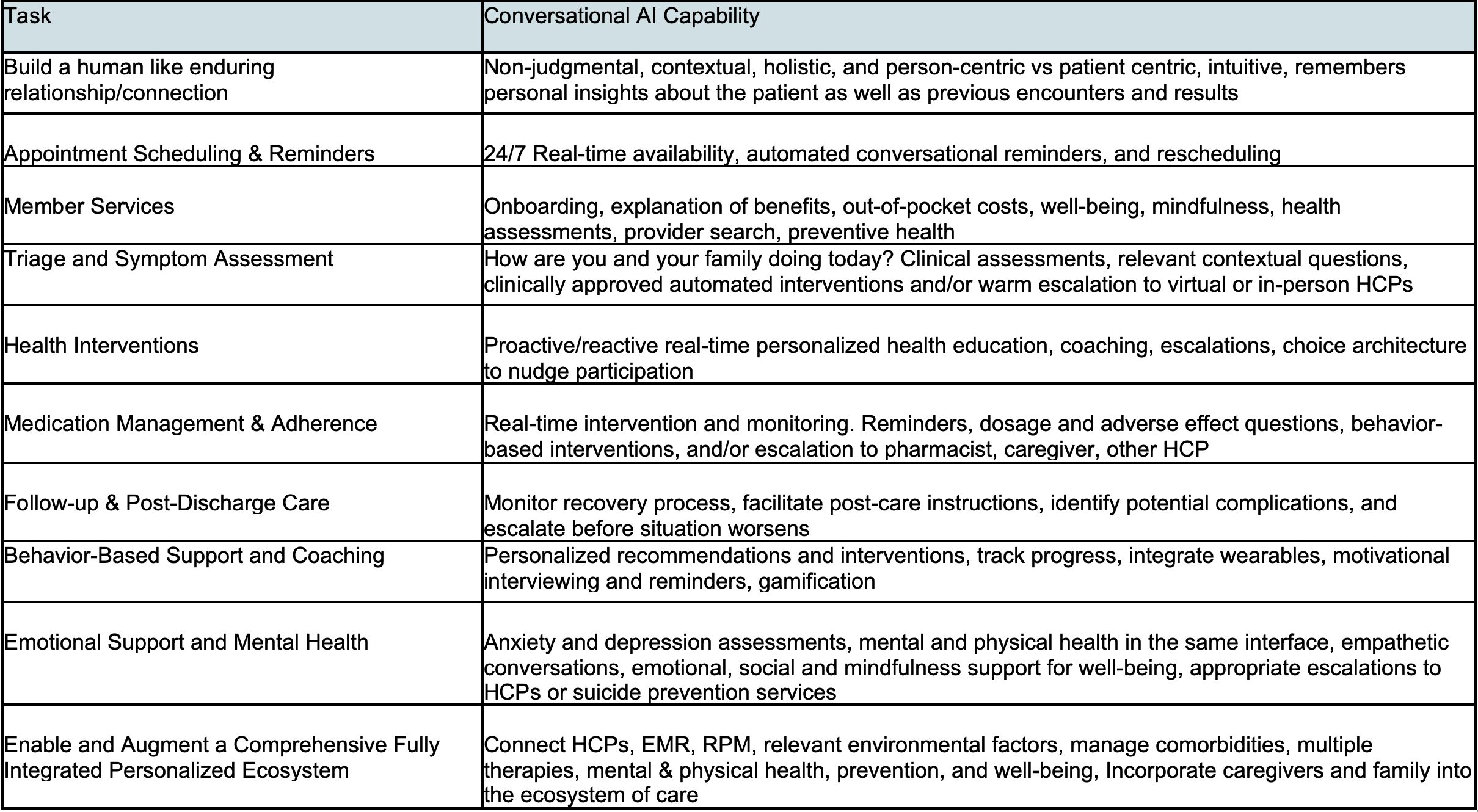
Finally! Let's talk about Generative AI and LLMs
It feels like we have suddenly landed in a science fiction movie that is no longer fiction—we hope more like the movie Her than The Terminator. The generative AI genie is out of the bottle, and nothing is going to quell the mad rush to leverage it.
At the risk of stating the obvious, there is no industry that carries more peril than health care as this fourth, and arguably most consequential, industrial revolution unfolds. Anything less than 100% accuracy is unacceptable in a digital clinical setting and the risk associated with any lack of accuracy must be mitigated and managed with aggressive oversight and control.
The system must know exactly what it does and does not know while being able to fail gracefully getting the user to the right resource and/or intervention—including ready access to HCPs—for resolution. Even if LLMs being right 80% of the time makes them the same as, or better than physicians, it cannot ethically or morally be turned loose on clinical care, which means it must be kept in well-trained and well-controlled lanes.
The good news is that these lanes represent extraordinarily meaningful impacts on our ability to deliver health. They include lanes that can facilitate specific administrative tasks, such as identifying the right facilities, finding the best HCP, scheduling appointments, etc.
More importantly, with the right controls in place (i.e., ongoing machine learning and humans-in-the-loop) to continuously evolve natural language understanding and to curate the most accurate and appropriate content and responses, it is infinitely exciting to think about the potential of generative AI to transform clinical care. Table 3 offers a glimpse into what generative AI can be trained to facilitate when properly controlled.
Table 3
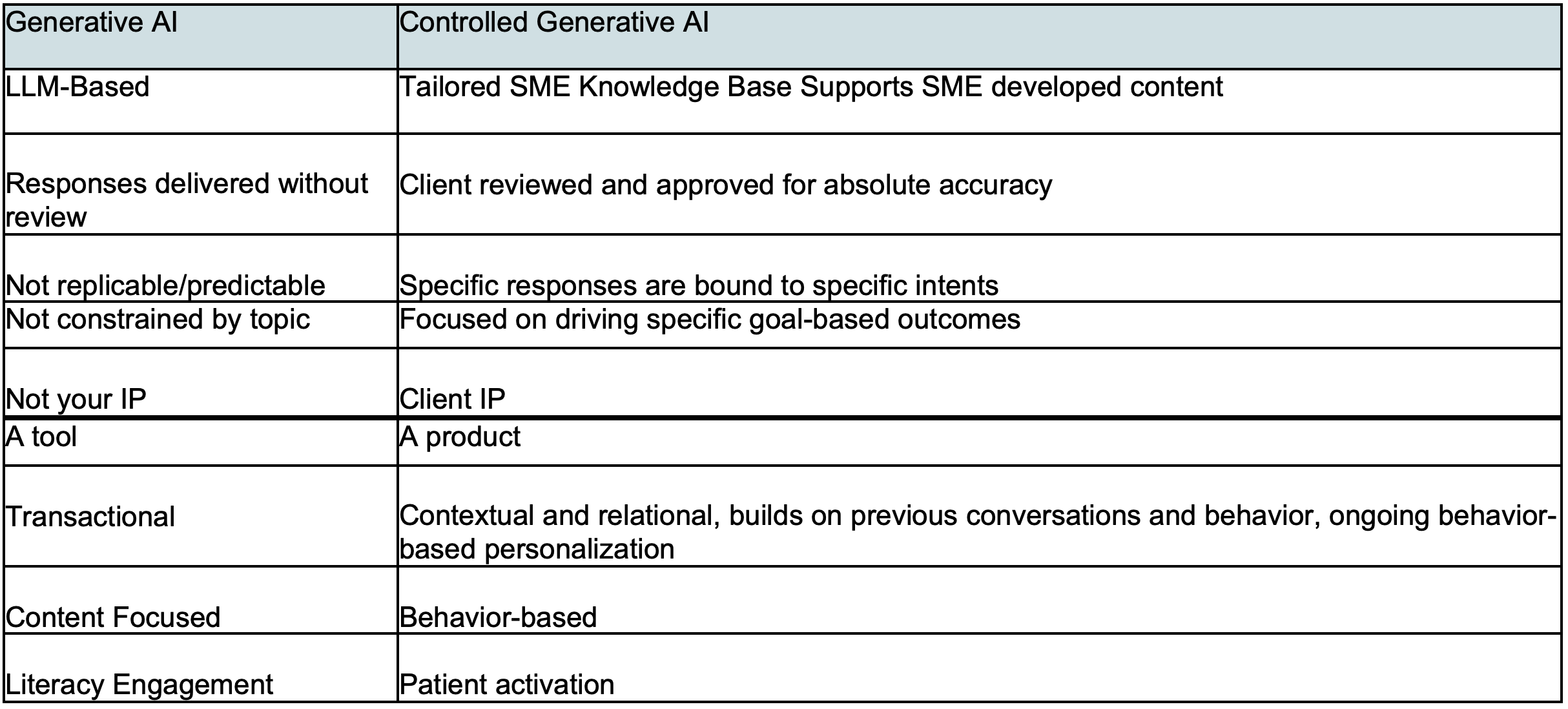
So, for the final time and with extreme prejudice, let's put a final nail in the coffin that holds all the arguments about AI’s ability to replace humans and bury it. Our health care system can only be sustained by deploying AI to augment humans. Having staked that, it’s not hyperbolic to suggest that AI is our last best hope to fix our health system. It is not irretrievably broken, and AI, in its many forms can and will be counted on to deliver true value-based care—whether pharma and other stakeholders are ready or not.
With HCPs being our most critical and increasingly scarcest resource, we must deploy AI in a way that enables them to operate at the top of their licenses and at scale. AI has put within our grasp the ability to enable a powerful, predictive, and personalized symphony of health system resources, analytics, HCPs, technology, medicine, behavior change, prevention, and trusted 3-dimensional, digitally-facilitated relationships that can empower our society—individually and collectively—to optimize health with efficiency and scale. Table 4 offers a glimpse into how this high precision participatory symphony between man, systems medicine, and AI will work.
Table 4
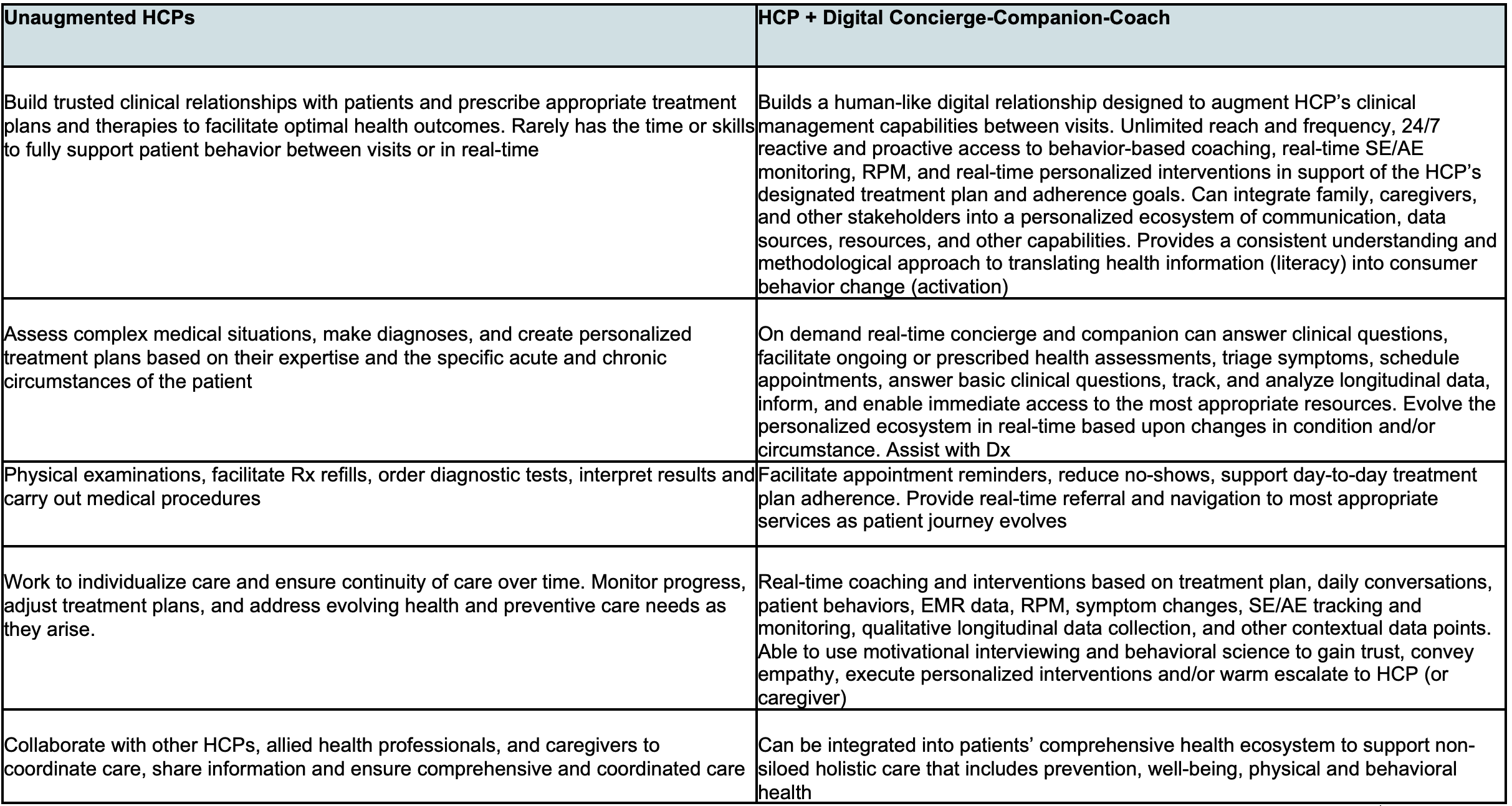
Bulger summarizes the unprecedented value proposition AI brings to mankind's eternal quest for optimized human health this way, “we now have the capability to deliver a fully integrated predictive, preventive, participatory, and personalized health ecosystem that can enable and empower patients to optimal levels of well-being.”
Certainly, there is much work to be done but it is within our reach today.
Newsletter
Stay informed on drug updates, treatment guidelines, and pharmacy practice trends—subscribe to Pharmacy Times for weekly clinical insights.






